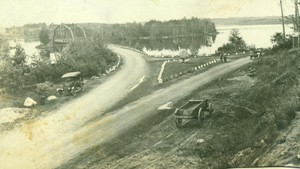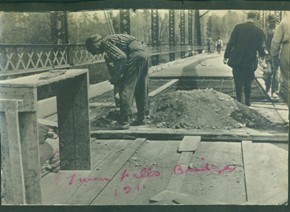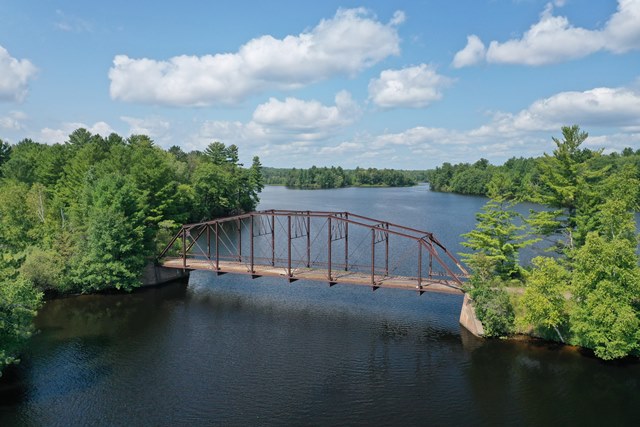We Recommend:
Bach Steel - Experts at historic truss bridge restoration.
BridgeHunter.com Phase 1 is released to the public! - Visit Now
Twin Falls Bridge

Primary Photographer(s): Nathan Holth
Bridge Documented: September 25, 2010 and October 2012
Rural: Dickinson County, Michigan and Florence County, Wisconsin: United States
1909 By Builder/Contractor: Central States Bridge Company of Indianapolis, Indiana
Not Available or Not Applicable
140.0 Feet (42.7 Meters)
140.0 Feet (42.7 Meters)
18.7 Feet (5.7 Meters)
1 Main Span(s)
Not Applicable

View Information About HSR Ratings
Bridge Documentation
View Original and US-2 Bypass Plan Sheets For This Historic Bridge
Physical Description
This abandoned bridge crosses the Menominee River, which at this point forms the border between Wisconsin and Michigan. An earthen causeway leads up to the bridge, with a longer causeway on the Wisconsin side. This bridge is a single span eight panel pin-connected Camelback through truss. A Camelback truss is a Parker truss that has a top chord / end post of exactly five slopes. The bridge is 140 feet long and has an 18.7 foot roadway. The truss is configured as follows: top chord and end post: back-to-back channels with cover plate and v-lacing; bottom chord: pairs of up-set eyebars; vertical members: back-to-back channels with v-lacing on each side; diagonal members: pairs of up-set eyebars; portal bracing: traditional A-frame design; sway bracing: unusual three panel Howe truss design composed of angles; railing: traditional hub-guard railing composed of two angles with one row of lattice; floorbeams: rolled American Standard Beams (i-beams); deck stringers: rolled American Standard Beams (i-beams); deck surface: concrete; abutments: concrete.
A Statement of Significance
Whether this bridge is considered to be a Michigan bridge or a Wisconsin Bridge, this historic truss bridge is clearly one of the most historically significant bridges in the region, and has state level significance in both Wisconsin and Michigan. In Michigan, the bridge's high level of significance is defined quite clearly: it is the only known example of a highway pin-connected Camelback truss bridge in the state. The significance is similar in Wisconsin, where the bridge is one of only two known examples of a highway Camelback truss bridge in the state. Further technological significance for the bridge arises from its excellent historic integrity, with the bridge exhibiting little to no alterations. Also, although the overall truss is traditionally composed, the sway bracing exhibits an unusual three panel Howe truss design. This design appears to have been used with the goal being the economical use of materials, since it may have saved material over a traditional sway bracing with a lattice design. The bridge is also a rare surviving example of a bridge built by the Central States Bridge Company.
History of Bridge
Original plans for the bridge survive and indicate that the bridge was built by the Central States Bridge Company of Indianapolis, Indiana. M.W. Torkelson, bridge engineer of Wisconsin performed design work for the bridge. Original plans for the bridge are dated 1909. The bridge apparently served an alignment of what became the US-2 highway, until a new US-2 bridge was built on new alignment in 1934. This new US-2 bridge was associated with a realignment of an entire section of US-2 highway, according to Michigan Highways. The truss bridge would likely have then assumed a role of carrying local traffic only, if that. It is likely this reason why the bridge has such good historic integrity with little alteration.
Very few examples of the Central States Bridge Company remain nationwide, although examples of their work can be found spread out over a number of states. Personal communication with James Stewart, and the 1984 Directory of American Bridge Building Companies 1840-1900 By Victor C. Darnell, and the 1903 A.I.S.A. directory provides some insight into the history of the Central States Bridge Company. The company began in New Castle, Indiana as the New Castle Bridge Company in 1897, relocating to Indianapolis c.1900. In 1903, the company had 5000 gross tons of production capacity making it a somewhat small bridge company. The company changed its name to Central States Bridge Company in 1905 and continued to operate into the 1930s. Known people who were officers or owners of the bridge company included Eugene Runyan, Thomas Campbell, John Campbell, and J. E. Troyer.
Above: Aerial view of bridge, August 27, 2020. Click for enlargement. Photo Credit: Doug Heim, Angelcopter, LLC
Historic Integrity of Bridge
All of the elements upon which a metal truss bridge's historic integrity is traditionally judged appear to be original and complete including all truss members and overhead bracing. There does not appear to have been replacement or loss of any truss or bracing members and chords. Further, no welded changes, modern bolts, or other major alterations or additions are apparent. All bracing and truss members and chords appear to be intact and complete. Further, even elements of the bridge that are traditionally given less or no consideration in terms of assessing historic integrity appear to be original and unaltered. The floorbeams appear to be original, as do the lattice hubguard railing (one panel of railing is missing). The stringers and the concrete deck follow the design outlined in the original plans and indeed physically appear as though they may be original, as unusual as that would be. The only change appears to have been the addition of an asphalt wearing surface.
![]()
Photo Galleries and Videos: Twin Falls Bridge
Bridge Photo-Documentation
Original / Full Size PhotosA collection of overview and detail photos. This gallery offers photos in the highest available resolution and file size in a touch-friendly popup viewer.
Alternatively, Browse Without Using Viewer
![]()
Bridge Photo-Documentation
Mobile Optimized PhotosA collection of overview and detail photos. This gallery features data-friendly, fast-loading photos in a touch-friendly popup viewer.
Alternatively, Browse Without Using Viewer
![]()
Drone Footage, Courtesy Doug Heim, Angelcopter, LLC
Full Motion VideoNote: The downloadable high quality version of this video (available on the video page) is well worth the download since it offers excellent 1080 HD detail and is vastly more impressive than the compressed streaming video. Streaming video of the bridge. Also includes a higher quality downloadable video for greater clarity or offline viewing.
![]()
Maps and Links: Twin Falls Bridge
This bridge is abandoned and closed to all traffic.
Coordinates (Latitude, Longitude):
Search For Additional Bridge Listings:
Bridgehunter.com: View listed bridges within 0.5 miles (0.8 kilometers) of this bridge.
Bridgehunter.com: View listed bridges within 10 miles (16 kilometers) of this bridge.
Additional Maps:
Google Streetview (If Available)
GeoHack (Additional Links and Coordinates)
Apple Maps (Via DuckDuckGo Search)
Apple Maps (Apple devices only)
Android: Open Location In Your Map or GPS App
Flickr Gallery (Find Nearby Photos)
Wikimedia Commons (Find Nearby Photos)
Directions Via Sygic For Android
Directions Via Sygic For iOS and Android Dolphin Browser
USGS National Map (United States Only)
Historical USGS Topo Maps (United States Only)
Historic Aerials (United States Only)
CalTopo Maps (United States Only)






